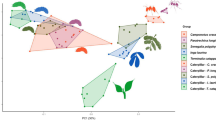Summary
Patchiness in herbivore attack is a well-documented phenomenon. When neighboring plants suffer vastly different levels of attack, then one suspects genotypic differences among plants to be the underlying mechanism. In this study, I use common garden experiments in two natural, but divergent, habitats at the Cedar Creek Natural History Area in central Minnesota to determine the role of plant genotype, environment and gender in plant resistance to a specialist herbivore. Resistance was measured by larval survivorship and weight. Eight clones ofRhus glabra were selected and 12 equal-aged ramets were dug up and planted in two gardens (each garden received 6 ramets per clone). First instarBlepharida rhois (Coleoptera: Chrysomelidae) larvae of known parentage were transferred to ramets and censused every other day. At the end of the experiment, larvae were collected and weighed. Analysis of variance was used to determine the importance of plant genotype, environment and gender on larval mortality and weight. The experiment was repeated in its entirety one month later. Both plant genotype and environment significantly affected larval survivorship in the first run of the experiment. No interactions were significant. Results from the second run indicated marginally significant genotype and environment main effects, and a genotype by environment interaction in larval survivorship. There was a significant genotype by environment interaction in larval weight on the same run. In neither run did clone gender have significant affects on resistance.
Similar content being viewed by others
References
Agren J (1987) Intersexual differences in phenology and damage by herbivores and pathogens in dioeciousRubus chamaemorus L. Oecologia 72:161–169
Agren J (1988) Between-year variation in flowering and fruit set in frost-prone and frost-sheletered populations of dioeciousRubus chamaemorus. Oecologia 76:175–183
Bawa KS, Opler PA (1978) Why are pistillate inflorescences ofSimarouba glauca eaten less than staminate inflorescences? Evolution 32:673–676
Crawley MJ (1985) Reduction of oak fecundity by low-density herbivore populations. Nature 314:163–164
Danell K, Elmqvist T, Ericson L, Salomonsson A (1985) Sexuality in willows and preference by bark-eating voles: defense or not? Oikos 44:82–90
Edmunds GF, Alstad DN (1978) Coevolution in insect herbivores and conifers. Science 199:941–945
Felt E (1907) White-marked tussock moth and the elm leaf beetle. NY State Mus Bull 109:9–14
Fritz RS, Sacchi CF, Price PW (1986) Competition versus host plant phenotype in species composition: willow sawflies. Ecology 67:1608–1618
Frost S (1973) Hosts and eggs ofBlepharida dorothea (Coleoptera: Chrysomelidae). Florida Entomol 56:120–122
Furth DG, Young DA (1988) Relationships of herbivore feeding and plant flavonoids (Coleoptera: Chrysomelidae and Anacardiaceae:Rhus). Oecologia 74:496–500
Gilbert E (1961) Phenology of Sumacs. Am Midl Nat 66:286–300
Haldane JBS (1949) Disease and Evolution. La Ricerca Scientifica [S] 19:68–76
Halkka O, Halkka L, Raatikainen M (1975) Transfer of individuals as a means of investigating natural selection in operation. Hereditas 80:27–34
Harborne JB (1979) Flavenoid pigments. In: Rosenthal GA, DH Janzen (eds) Herbivores, their interactions with secondary plant metabolites. Academic Press, New York, pp 619–655
Hedrick PW (1986) Genetic polymorphism in heterogeneous environments: a decade later. Ann Rev Ecol Syst 17:535–566
Karban R (1988) Effects of clonal variation of the host plant, interspecific competition and climate on the population size of a folivorous thrips. Oecologia 74:298–303
Kraft SJ, Denno RF (1982) Feeding responses of adapted and non-adapted insects to the defensive properties ofBaccharis halimifolia L. (Compositae). Oecologia 52:156–163
Larch CM, Sakai AK (1983) Successional and clonal changes at sites of smooth sumac (Rhus glabra). The Michigan Bot 22:3–9
Maddox GD, Cappuccino N (1986) Genetic determination of plant susceptibility to an herbivorous insect depends on environmental context. Evolution 40(4):863–866
Maddox GD, Root RB (1987) Resistance to 16 diverse species of herbivorous insects within a population of goldenrod,Solidago altissima: genetic variation and heritability. Oecologia 72:8–14
Riley E (1874) The jumping sumach beetle —Blepharida rhois (Forst.). Sixth Ann Rep Miss Ent 118–122
Service P (1984) Genotypic interactions in an aphid-host relationship:Uroleucon rudbeckiae andRudbeckia laciniata. Oecologia 61:271–276
Strauss SY (1988) Interactions among three herbivores and their effects on a shared host plant,Rhus glabra. Ph.D. Dissertation, Florida State University
Strauss SY, Morrow PA (1988) Movement patterns of an Australian chrysomelid beetle in a stand of twoEucalyptus host species. Oecologia 77:231–237
Via S (1984) The quantitative genetics of polyphagy in an insect herbivore. I. Genotype-environment interaction in larval performance on different host plant species. Evolution 38(4):881–895
Whitham TH, Mopper S (1985) Chronic herbivory: impacts on architecture and sex expression of pinyon pines. Science 228:1089–1091
Young DA (1979) Heartwood flavonoids and the infrageneric relationships ofRhus (Anacardiaceae). Am J Bot 66:502–510
Author information
Authors and Affiliations
Rights and permissions
About this article
Cite this article
Strauss, S.Y. The role of plant genotype, environment and gender in resistance to a specialist chrysomelid herbivore. Oecologia 84, 111–116 (1990). https://doi.org/10.1007/BF00665603
Received:
Accepted:
Issue Date:
DOI: https://doi.org/10.1007/BF00665603




